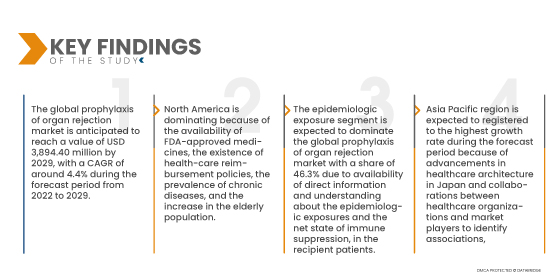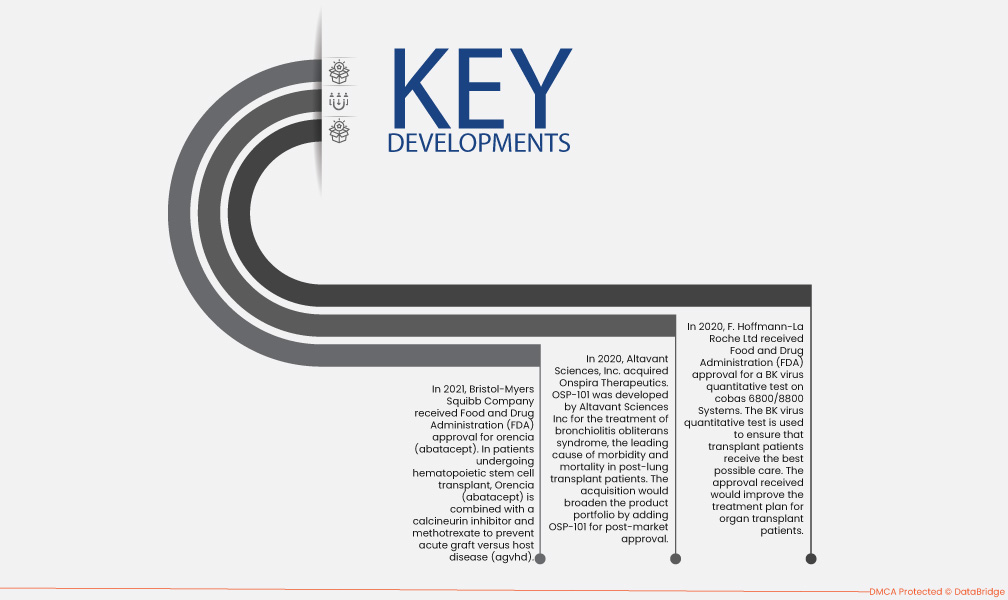Organ transplantation is the surgical process of eliminating an organ from one person (donor) and surgically placed into the body of the recipient, whose particular organ has stopped functioning. In 2020, the United Network for Organ Sharing (UNOS) facts stated that about 39,036 organ transplants had taken place.
Access Full Report @ https://www.databridgemarketresearch.com/reports/global-prophylaxis-of-organ-rejection-market
Before organ transplantation, the blood of the receiver is screened for antibodies in contradiction of the tissues of the donor. The occurrence of organ transplantations in countries depends on the indication and time of the transplantation. For instance, in the first year post transplantation of renal tissues, the occurrence of kidney transplantation can be more. The data provided shows the majority of organ transplantations of important organs.
Data Bridge Market Research analyses that the Prophylaxis of Organ Rejection is expected to grow at a CAGR of 4.4% in the forecast period of 2022 to 2029 and is expected to reach USD 2,781.83 million by 2021 and USD 3,894.40 million by 2029.
Key Findings of the Study
Rise in Chronic Diseases Are Expected to Drive the Market
Chronic diseases are those whose morbidity conditions are persisting for more than one year. These types of diseases require a medical attention and treatment. The organs which are usually transplanted are heart, kidney and lungs. The severity of disease in these organs, increase with age, lack of physical activity.
For instance,
- In 2018, the National Kidney Foundation Inc. data indicated that 785,883 patients in the U.S. had required kidney transplants for survival because they had a kidney failure. 554,038 of these patients received dialysis to substitute kidney function, and 229,887 survived with a kidney transplant.
Report Scope and Market Segmentation
|
Report Metric
|
Details
|
|
Forecast Period
|
2022 to 2029
|
|
Base Year
|
2020
|
|
Historic Years
|
2019 (Customizable to 2014 - 2019)
|
|
Quantitative Units
|
Revenue in USD Million, Volumes in Units, Pricing in USD
|
|
Segments Covered
|
Cause (Epidemiologic Exposure, Antibacterial Prophylaxis, Prophylaxis Against Other Pathogens And Others), Treatment (Outpatient Immunosuppressant, Inpatient Immunosuppressant And Others), Route Of Administration (Oral, Intravenous), Organ (Kidney, Liver, Heart, Lung, Others), Patient Type (Pediatric, Adults), End User (Hospitals, Clinic Home Healthcare And Others), Distribution Channel (Direct Tender, Pharmacy Stores And Others)
|
|
Countries Covered
|
U.S., Canada and Mexico in North America, Germany, France, U.K., Netherlands, Switzerland, Belgium, Russia, Italy, Spain, Turkey, Rest of Europe in Europe, China, Japan, India, South Korea, Singapore, Malaysia, Australia, Thailand, Indonesia, Philippines, Rest of Asia-Pacific (APAC) in the Asia-Pacific (APAC), Saudi Arabia, U.A.E, South Africa, Egypt, Israel, Rest of Middle East and Africa (MEA) as a part of Middle East and Africa (MEA), Brazil, Argentina and Rest of South America as part of South America
|
|
Market Players Covered
|
Ossium Health, Inc (U.S.), Alphamab Oncology (China), Altavant Sciences, Inc (U.S.), Hansa Biopharma (Sweden), Concord Biotech (India), Panacea Biotec (India), WOCKHARDT (India), SEBELA PHARMACEUTICALS (U.S.), Accord-UK Ltd (U.K.), Veloxis Pharmaceuticals, Inc (Denmark), Astellas Pharma Inc (Japan), Novartis AG (Switzerland), Bristol-Myers Squibb Company (U.S.), Dr Reddy’s Laboratories, Ltd (India), Viatris Inc (U.S.), Strides Pharma Science Limited (India), Glenmark (India), Biocon (India), Pfizer Inc (U.S.), F. Hoffmann-La Roche Ltd (Switzerland)
|
|
Data Points Covered in the Report
|
In addition to the market insights such as market value, growth rate, market segments, geographical coverage, market players, and market scenario the market report curated by the Data Bridge Market Research team includes in-depth expert analysis, patient epidemiology, pipeline analysis, pricing analysis, and regulatory framework.
|
Segment Analysis:
The global prophylaxis of organ rejection market is categorized into seven notable segments based on cause, treatment, route of administration, organ, patient type, end user and distribution channel.
- On the basis of cause, the global prophylaxis of organ rejection market is segmented into epidemiologic exposure, antibacterial prophylaxis, prophylaxis against other pathogens and others. The epidemiologic exposure segment is expected to dominate the global prophylaxis of organ rejection market with a share of 46.3% due to availability of direct information and understanding about the epidemiologic exposures and the net state of immune suppression, in the recipient patients.
- On the basis of treatment, the global prophylaxis of organ rejection market is segmented into outpatient immunosuppressant, inpatient immunosuppressant and others. The outpatient immunosuppressant segment is expected to dominate the global prophylaxis of organ rejection market with a share of 84.5% since it can achieve the sustained and specific immune response against damaged cells.
- On the basis of route of administration, the global prophylaxis of organ rejection market is segmented into oral and intravenous. The oral segment is expected to dominate the global prophylaxis of organ rejection market with a share of 84.8% due to increased availability and intake of oral tablets and capsules.
- On the basis of organ, the global prophylaxis of organ rejection market is segmented into kidney, liver, heart, lung and others. The kidney segment is expected to dominate the global prophylaxis of organ rejection market with a share of 66.72% due to increased incidence of kidney failure and presence of reimbursement policies such as Medicare, for the recipient’s insurance.
- On the basis of patient type, the global prophylaxis of organ rejection market is segmented into pediatric, adults.
The adult segment is expected to dominate the global prophylaxis of organ rejection market
The adult segment is expected to dominate the global prophylaxis of organ rejection market with a share of 89.9% due to increased prevalence of chronic diseases and weaker immune system in adults and resulting in longer waiting list of adult recipients than children and women.
- On the basis of end user, the global prophylaxis of organ rejection market is segmented into hospitals, clinics, home healthcare and others. The hospital and clinic segment is expected to dominate the global prophylaxis of organ rejection market with a share of 59.5% due to rise in medical care and collaboration with other hospitals for delivery of the donor organs to the recipient patients are predicted to dominate the market.
- On the basis of distribution channel, the global prophylaxis of organ rejection market is segmented into direct tenders, pharmacy stores and others.
The direct tenders segment is expected to dominate the global prophylaxis of organ rejection market
The direct tenders segment is expected to dominate the global prophylaxis of organ rejection market with a share of 47.0% due to surge in demand of outpatient immunosuppressant by pharmaceutical companies and guaranteed payment, are predicted to dominate the market.
Major Players
Data Bridge Market Research recognizes the following companies as the major prophylaxis of organ rejection market players in prophylaxis of organ rejection market are Ossium Health, Inc (U.S.), Alphamab Oncology (China), Altavant Sciences, Inc (U.S.), Hansa Biopharma (Sweden), Concord Biotech (India), Panacea Biotec (India), WOCKHARDT (India), SEBELA PHARMACEUTICALS (U.S.), Accord-UK Ltd (U.K.), Veloxis Pharmaceuticals, Inc (Denmark), Astellas Pharma Inc (Japan), Novartis AG (Switzerland), Bristol-Myers Squibb Company (U.S.), Dr Reddy’s Laboratories, Ltd (India), Viatris Inc (U.S.), Strides Pharma Science Limited (India), Glenmark (India), Biocon (India), Pfizer Inc (U.S.), F. Hoffmann-La Roche Ltd (Switzerland)
Market Development
- In 2020, Altavant Sciences, Inc. acquired Onspira Therapeutics. OSP-101 was developed by Altavant Sciences Inc for the treatment of bronchiolitis obliterans syndrome which is the leading cause of mortality and morbidity in post-lung transplant patients. The acquisition would broaden the product portfolio by adding OSP-101 for post-market approval.
- In 2021, Bristol-Myers Squibb Company received Food and Drug Administration (FDA) approval for orencia (abatacept). In patients undergoing hematopoietic stem cell transplant, Orencia (abatacept) is combined with a calcineurin inhibitor and methotrexate to prevent acute graft versus host disease (agvhd). With the approval, orencia (abatacept) will become an important treatment option for the prevention of liver rejection. The orencia (abatacept) could meet an unmet medical need for organ rejection.
- In 2020, F. Hoffmann-La Roche Ltd received Food and Drug Administration (FDA) approval for a BK virus quantitative test on cobas 6800/8800 Systems. The BK virus quantitative test is used to ensure that transplant patients receive the best possible care. The approval received would improve the treatment plan for organ transplant patients.
Regional Analysis
Geographically, the countries covered in the prophylaxis of organ rejection market report are U.S., Canada and Mexico in North America, Germany, France, U.K., Netherlands, Switzerland, Belgium, Russia, Italy, Spain, Turkey, Rest of Europe in Europe, China, Japan, India, South Korea, Singapore, Malaysia, Australia, Thailand, Indonesia, Philippines, Rest of Asia-Pacific (APAC) in the Asia-Pacific (APAC), Saudi Arabia, U.A.E, South Africa, Egypt, Israel, Rest of Middle East and Africa (MEA) as a part of Middle East and Africa (MEA), Brazil, Argentina and Rest of South America as part of South America
As per Data Bridge Market Research analysis:
North America is the dominant region in prophylaxis of organ rejection market the forecast period 2022 - 2029
North America is dominating because of the availability of FDA-approved medicines, the existence of health-care reimbursement policies, the prevalence of chronic diseases, and the increase in the elderly population. The epidemiologic exposure segment is dominating due to the availability of direct information and understanding about epidemiologic exposures and the net state of immune suppression in recipient patients in the United States.
Asia-Pacific is estimated to be the fastest growing region in prophylaxis of organ rejection market the forecast period 2022 - 2029
Asia Pacific region is expected to registered to the highest growth rate during the forecast period because of advancements in healthcare architecture in Japan and partnerships between healthcare organizations and market players to identify associations, a potential cause of a weak immune system responsible for organ rejection has been identified.
For more detailed information about the prophylaxis of organ rejection market report, click here – https://www.databridgemarketresearch.com/reports/global-prophylaxis-of-organ-rejection-market












